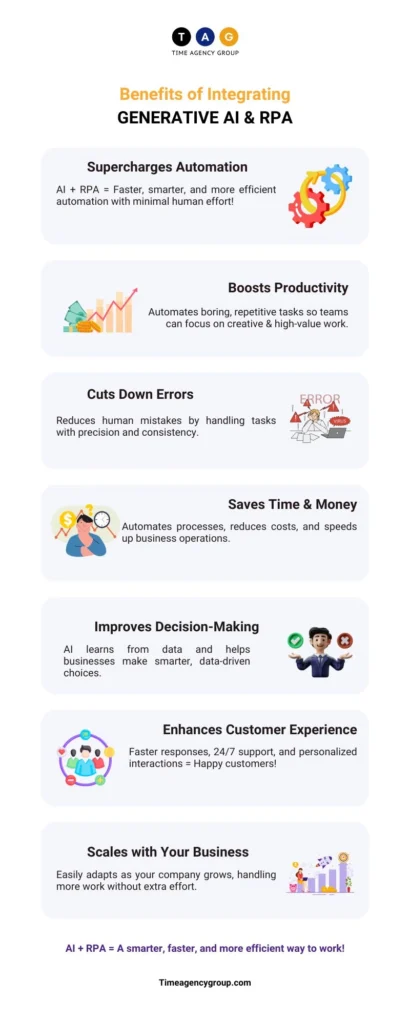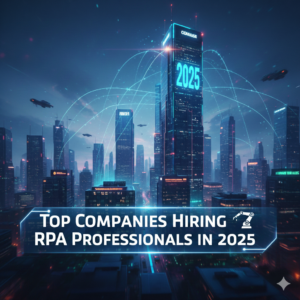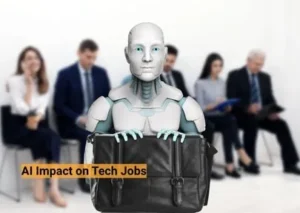The interest of organizations in automation and artificial intelligence technologies causes them to develop products that would gradually strengthen the process of inter-organizational automation and the simplification of the market. RPAs flatten processes for customers because they assist employees by providing information, which helps in the effective management of tasks. This blog explores the benefits of integrating Generative AI and RPA, showcasing how their synergy enhances technology flexibility and adaptability.
Understanding Generative AI and RPA
One must learn all the basic concepts of Generative AI and RPA before the inclusion of these two technologies:
Generative AI: A creative AI (Citizenship) constructs a branch of AI that takes on the courage to generate fresh information. Such as text, images, or even code, which is based on patterns that the system has incorporated and the data it has trained on. Its uses lie in natural language processing, content generation, and creative tasks.
Robotic Process Automation: It is the software robots or software “bots” that are employed in automating simple, rule-based tasks in the business routine. By doing so, RPA is supposed to liberate the employees from tedious activities, to eliminate the errors. And thus to increase the efficiency as well.
10 Benefits of Integrating Generative AI and RPA
The synergistic power of the Generative AI and RPA integration is the emphasis on the strengths of both technologies. The automation process can then synthesize a cause-and-effect relationship that positively impacts several active areas of big business.
Augmented Decision-Making
The synthesis between generative AI and RPA is what makes it possible for companies. Generative AI is best known for finding patterns in large datasets, extracting considerable meaningful information, and providing recommendations. When these powers come together with RPA systems. The information gathered can be directly involved to enhance and help in correct decision-making processes.
Through this combination, organizations can quickly and to date decisions based on data guaranteed with better accuracy. Using the analytical ability generative AI offers together with the operational proficiency. RPA has enabled businesses to modify their decision-making framework such that it includes the highly developed technology available, which would then lead to a tradeoff between technology and performance based on knowledge.
Intelligent Automation
The merging of RPA and AI, which is generative, is now the new way of intellectual automation. RPA is good at doing repetitive tasks, but adding Generative AI to the mix brings these processes to a higher level. A combination of Generative AI and RPA which is a complete machine part, forms a very efficient system, which can perform not only simple tasks but also complex tasks without formal guidelines.
In this manner, firms can beef up automation tools and leverage higher pace and improvisation through diversified operational areas. This strategic automation helps streamline workflows as well as bring in newer insights into quality. Beyond that, it is a very productive way of getting the job done.
Natural Language
Understanding Generative AI, which expresses itself in human-like texts, has given remarkable opportunities to businesses that operate in the areas of customer service, content creation, and chatbots. Through the collaboration of this capability and RPA, companies can restore and enhance the user experience to a significant level.
This collaboration creates the workflows of customer-employee communication, which look almost like live conversations by their nature. It is a new approach that changes how companies interact with their customers and ensures a more personal and efficient service, especially when the operation requires a precise understanding of the language and the generation of the response.
Predictive Analytics
The combination of machine learning technologies and computer vision in the research and development department of a corporation is one of the most drastic actions to improve organizational efficiency. By doing so, we can tell that AI can provide analysis of the historical data and then forecast the future trends which is the most significant thing for the forecasting purpose.
Along with that, it also helps the organizations to get an edge by dealing with the underlying issues through Root Cause Analysis, thus optimizing resource allocation, and consequently increasing the operational efficiency. Hence, the connection facilitates the serviced businesses to forecast needs upcoming and obstacles of today thus, to be ahead of the game in the volatile situation of the market.
Scalable Workforce
With a combination of RPA bots and Generative AI, a scalable workforce that can adjust to fluctuating demands is born. RPA bots, the ones that are known for their laziness and can work without rest 24/7 get an additional layer of adaptability when they are welcomed by Generative AI.
This collaboration is capable of keeping the company running at a consistent and efficient pace even when pressure and work intensify. The adoption of this scalable approach is important for companies that are willing to embrace operational resilience and adaptability in an ever-changing market environment.
Enhanced Adherence to Regulations
The collaboration of RPA and Generative AI substantially increases the compliance level in the operations of the institutions. The system mechanism of RPA performing a consistent task without infringing on predetermined principles is reinforced by the AI that can track and process data. This introduction makes sure people are more in line with the right commercial procedures and continue at a faster pace more efficiently. Therefore, it is such a pivotal format that entities should stick to prevent any dangers and develop honesty in carrying out activities.
Data Extraction and Processing Generative
AI considerably boosts the capacity of RPA in data extraction and processing, especially from unstructured sources like documents and images. When it comes to their functions in RPA workflows, it simplifies all tasks of data entry as well as validation. Thus, the procedure will become efficient, and fewer errors will occur. The arrival of this mix in advanced technical solutions means a huge step forward in dealing with many different types of data and, thus, a new path to automation and data effectiveness processing tasks.
Hyper-Personalization Generative
AI integration with RPA makes it possible for companies to accomplish hyper-personalization in customer interactions. Generative AI’s ability to analyze customer data makes it possible to create unique materials and recommendations. This functionality, when integrated with RPA workflows, implements a way of providing extremely personalized customer experiences, thus, customer engagement and satisfaction are both elevated. This synergy in customer engagement results in more personal and direct communication that allows customers to interact based on their preferences and behaviors.
Cost Reduction
The combination of generative AI and RPA is a powerful cost reduction method in the department of business operations. This synergy goes beyond automation, and it comes with the factor of efficiency. As a result, businesses benefit from a lot of savings. With the help of AI machine learning technology, it perfectly drives forecasting with sustainable procurement programs. Creating more insightful employee experiences and journeys is another endeavor that such companies take up.
Conclusion
When Generative AI and RPA are combined, they lead to the massive growth of businesses. The tools do the job more skillfully and are what make people do work with more efficiency and in less time. Such a partnership has an undeniable impact on the accuracy of data as well as the quality of decision-making and immediately shifts the operational perspective of the employees. It also accelerates the procedures, reduces costs, and enriches the customer experience. Along the way, companies that utilize Generative AI with RPA technology will continue to be the pace-setters and can expect much more success than others.
FAQs
How RPA and AI can be fused is the major discussion?
The RPA’s ability to automate simple tasks, processes, or workflows, coupled with AI’s judgment and learning capabilities, is intelligent process automation. The nations that merit the creation of a new service both wear different hats, and then they grow their generalizability through several user feedbacks hence, they come up with a virtual list of problems and solutions. After the task has been solved, the system alerts staff members. Subsequently, the staff follows the procedure to correct the task.
How do RPA and AI work together in benefits & use cases?
The combination of RPA and AI can automate those processes in a way that allows your human resources to be more sacrilegious in the tasks where they can have the greatest impact. Streamline the process of automatically aggregating and grouping employee workflows and make use of AI to automatically recognize the recurring tasks you want to include in your automation pipeline.
Harness the power of Generative AI and Robotic Process Automation (RPA) to automate complex tasks, improving decision-making and boosting productivity. With the expertise of a robotic process automation recruiting partner, reduce manual effort, minimize errors, and implement innovative business solutions. Start automating smarter today!
Infographic







